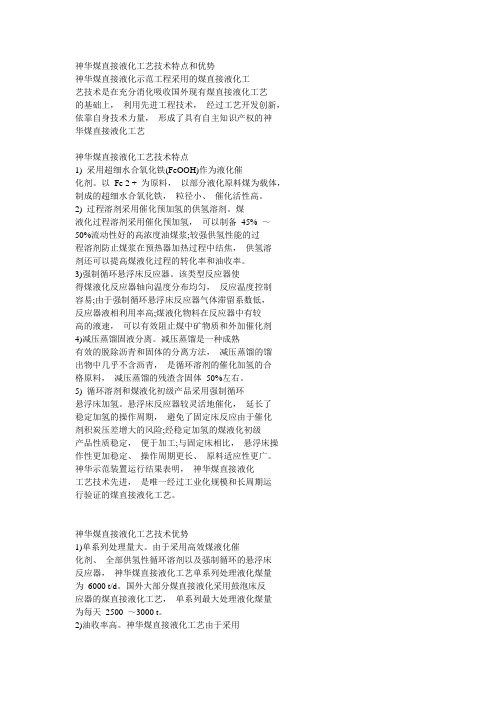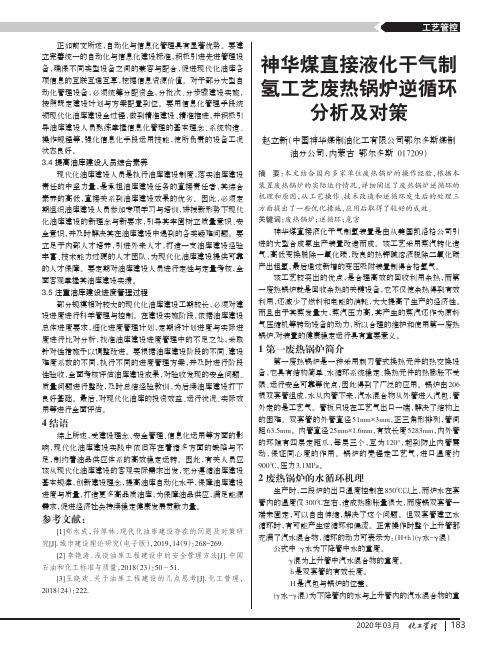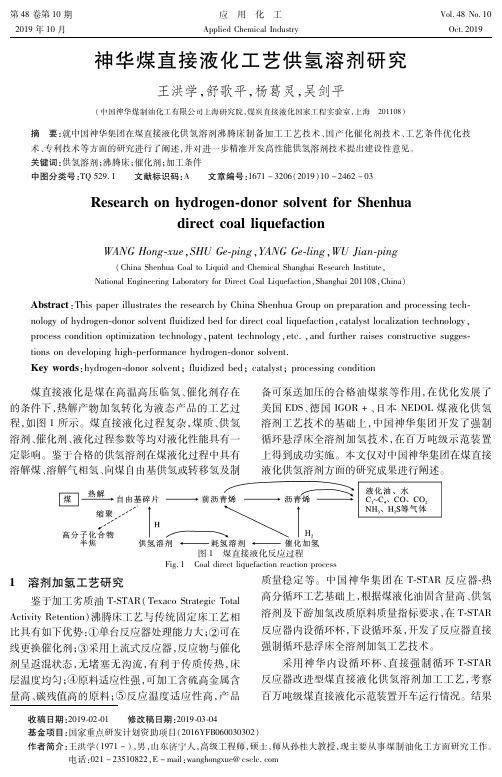神华煤直接液化工艺及PU情况介绍-神华舒歌平
神华煤直接液化工艺及PU情况介绍-神华舒歌平

• 停留时间:0.37t/m3h Residence time: 0.37t/m3h • 油收率:37% Oil Yield Rate: 37%
煤直接液化工艺发展概况
Development of DCL Process
油收率 45% 44% 51% 58% 54% 58%
日本 日本
BCL NEDOL
50 150
煤直接液化工艺发展概况
Development of DCL Process
煤直接液化工艺发展经历了三个阶段的 革命性进步。
DCL Process has reached 3 milestones
主要特征表现在循环溶剂制备工艺上, 即固液分离工艺和溶剂加工技术。
煤炭直接液化工艺发展概况
Development of Direct Coal Liquefaction (DCL) Process
煤炭直接液化工艺 DCL Process
煤炭直接液化技术1913年德国人发明,二战期间,德 国的煤直接液化工厂生产能力达到年产423万吨成品油。 DCL technology was invented in 1913 in Germany, during World WarⅡ, the country’s DCL capacity reached 4.23 million ton oil per year 目标是破坏煤的有机结构,并进行加氢,使其成为液 体产物。虽然开发了多种不同种类的煤炭直接液化工 艺,但就基本化学反应而言,它们非常接近。 There are several DCL technologies, but the basic chemical reactions are similar that destroy the to Coal’s organic structure and then hydrogenation
中国神华煤直接液化工艺的工艺流程

中国神华煤直接液化工艺的工艺流程下载提示:该文档是本店铺精心编制而成的,希望大家下载后,能够帮助大家解决实际问题。
文档下载后可定制修改,请根据实际需要进行调整和使用,谢谢!本店铺为大家提供各种类型的实用资料,如教育随笔、日记赏析、句子摘抄、古诗大全、经典美文、话题作文、工作总结、词语解析、文案摘录、其他资料等等,想了解不同资料格式和写法,敬请关注!Download tips: This document is carefully compiled by this editor. I hope that after you download it, it can help you solve practical problems. The document can be customized and modified after downloading, please adjust and use it according to actual needs, thank you! In addition, this shop provides you with various types of practical materials, such as educational essays, diary appreciation, sentence excerpts, ancient poems, classic articles, topic composition, work summary, word parsing, copy excerpts, other materials and so on, want to know different data formats and writing methods, please pay attention!中国神华煤直接液化工艺是一种先进的煤炭转化技术,可以将煤炭转化为优质的液体燃料。
神华煤直接液化工艺简介

神华煤直接液化工艺简介根据煤直接液化过程中溶剂的作用机理,即溶解煤并分散热解产生的自由基,和及时提供活性氢使自由基稳定,防止发生聚合反应,就要求循环溶剂具有对重质芳香物的溶解性好,同时又有能够释放出氢的化合物。
显然,合适的循环溶剂只能是含有较多稠环芳香烃并经部分加氢的物料。
一般认为,供氢溶剂中提供的氢的反应活性比气态氢要高许多,在高压催化加氢体系中,气相氢是通过与溶剂反应后再转移至煤的。
所以,对循环溶剂的加氢深度要适宜,才能保证溶剂中氢的反应活性高,数量多。
在神华煤直接液化工艺中,将常压蒸馏塔全部馏出物和减压蒸馏塔的全部馏出物进入T-Star装置,按供氢溶剂要求的深度加氢后提供供氢溶剂。
煤浆制备采用全部供氢溶剂配制。
神华煤直接液化工艺采用全部加氢溶剂后,煤浆浓度为45%时,粘度为90厘泊(60℃),煤浆浓度为48%时,粘度为240厘泊(60℃)。
采用减压蒸馏,并通过对其馏份油进行适宜深度的加氢后,作为循环溶剂是保证循环溶剂质量的可靠方法。
因为减压蒸馏分离出的重油含有大量的稠环芳烃,只含极少量的沥青和固体物,通过控制加氢深度来部分饱和稠环芳烃,是其即有溶解分散能力,又有供氢性能。
并且以此溶剂可以配制高浓度的油煤浆,而油煤浆的粘度却适中。
同时,由于溶剂性能的提高,液化条件可以大大缓和,煤在反应器的停留时间可以大大减少,反应器利用率可以提高。
煤液化反应中,除了含有液化生成油外,还含有大量的固体残渣(包括灰和未转化的煤与催化剂)以及沥青类。
因此,对煤液化反应生成物的固液分离,是构成煤液化工艺的一个重要部分。
众所周知,已有的煤液化固液分离方案包括:减压蒸馏、过滤分离和溶剂萃取等。
考虑到技术可靠性、设备的适用性和对分离出的固、液要求指标,以及这些技术在现有工业上的使用效果和成熟程度。
神华煤液化项目选择减压蒸馏技术来分离固液,原因是:1)该技术在炼油化工领域大量使用并且十分成熟;2)采用该技术所获得的油收率并不低。
挑战美国工艺他用中国技术把煤变油

龙源期刊网 挑战美国工艺他用中国技术把煤变油作者:张景阳来源:《科学之友》2019年第08期在一片蓝色的“工衣海洋”里,有一个人既忙碌又紧张,指导最后的检查和临时增加的技术改造工作,对每一个环节,他都一一过问,事无巨细。
只见此人身材魁梧,嗓门大,说话幽默、直接。
“采访我是件很简单的事,因为我这辈子只做了一件事!”还不等笔者说话,他就先哈哈大笑起来。
他就是国家能源集团化工公司总工程师舒歌平。
1978年,高中毕业的舒歌平考入杭州大学(现并入浙江大学)化学系,本科毕业后,又考入煤炭科学研究总院(下简称煤科总院)攻读硕士学位。
“就在我读研那年,根据国家‘六五’‘七五’计划,煤科总院建立起了当时国内最先进的煤炭液化实验装置,也是从那时起,我开始接触到煤液化工艺,这一接触,就一辈子都没放开。
”舒歌平回忆说。
熟悉舒歌平的人都说,我国的煤制油项目刚刚上马,舒歌平就一头扎进去,那时他还是个学生,等他再出来时,就成了总工程师。
这过程听起来容易,其实充满了坎坷。
在煤科总院读书时,舒歌平脑子里经常会冒出一些新奇的想法:石油,是大自然赐予人类的宝贵财富,已被广泛应用于人类生产生活的各个方面。
煤炭,同样是大自然的馈赠,当时却主要被用于发电领域。
煤与石油,一个固体,一个液体,在外观形态和使用方式上有很大不同,但其主要成分都是碳,我国富煤贫油少气,能否把煤变成石油呢?舒歌平并不只是简单想想,而是边想边研究。
舒歌平说:“早在20世纪初,西方国家就已经有了煤液化技术,但那时相关工艺比较原始、成本極高,储备技术主要是为战争需要。
后来随着中东发现大量的石油,煤液化技术逐渐被很多国家遗忘。
但是我国的特殊情况要求我们一定要掌握一套成熟的煤液化技术,这是时代发展的必然要求。
”基于这样的思考,舒歌平从20多年前开始,就确定了为煤制油事业奋斗终身的目标。
2002年,神华集团(国家能源集团前身,2017年中国国电集团和神华集团合并重组为国家能源集团)启动了煤直接液化项目,已是业内杰出科学家的舒歌平作为不二人选应邀加入。
神华集团公司煤液化项目情况

神华集团公司煤液化项目情况就目前了解的情况,神华在国内煤制油领域在投资和技术方面均处于领头羊的位置。
在煤制油的两条技术路线上,神华均有所动作。
神华企业概况神华集团有限责任公司(简称神华集团)是于1995年10月经国务院批准组建的国有独资公司,前身为华能集团属下的华能精煤公司(1985年成立)。
中央直管的53户国有重要骨干企业之一。
在国家计划和中央财政实行单列,享有对外融资权、外贸经营权、煤炭出口权。
神华集团以能源为主业,集煤矿、电厂、铁路、港口、航运为一体,实施跨地区、跨行业、多元化经营,是我国最大的煤炭企业。
神华集团负责统一规划和开发经营神府东胜煤田的煤炭资源和与之配套的铁路、电厂、港口、航运船队等项目。
神府东胜煤田位于中国陕西省榆林地区和内蒙古伊克昭盟境内。
属世界八大煤田之一,已探明煤田含煤面积3.12万平方公里,地质储量2236亿吨。
目前,神华集团拥有全资及控股子公司30家,职工约9万人。
截止2002年底,总资产1026亿元。
神华集团目前拥有银行信贷额度超过1500亿元。
2002年,神华集团商品煤销售7773万吨,主营业务收入258亿元,还本付息56.02亿元,利润总额23.19亿元。
集团综合实力大幅度提高。
神华集团已连续两年在国务院五部委对全国169家中央企业进行综合效绩考评中,位居全国煤炭行业第一。
中国神华煤制油有限公司作为神华集团的全资企业,经国家工商行政管理总局批准,于2003年6月12日在北京成立,公司注册资金为20亿元人民币。
神华煤液化项目情况1. 神华的直接煤变油项目2004年8月,获得国家发改委批准的神华集团内蒙古直接液化项目破土动工,2005年4月18日核心装置开始建设,这是世界上唯一的大型煤直接液化项目。
项目地址:内蒙古伊金霍洛旗乌兰木伦镇,建设总规模为年产油500余万吨,分两期建设,其中一期工程由三条主生产线组成,包括煤液化、煤制氢、溶剂加氢、加氢改质、催化剂制备等14套主要生产装置。
神华煤直接液化项目反应系统优化改造及效果分析

神华煤直接液化项目反应系统优化改造及效果分析逯波【摘要】介绍了神华煤直接液化项目反应系统的工艺.提出了该工艺反应系统运行中的问题,包括高压紧急冲洗油流量波动大、反应器分离器焦炭沉积、高压差角阀的热备操作性差、膜分离效率下降、反吹氢气带液严重、开工升温过程慢等.分析了出现问题的原因.通过高压紧急冲洗油泵增加变频稳定了流量,节约了电能;反应器分离器内采取防沉积措施,减少了结焦物的沉积;高压差角阀增加单项阀跨线,优化伴热,达到高温减压管路的在线热备;膜分离优化流程,提高了氢气回收率,年创造效益2 232万元.反吹扫氢增加脱液罐,脱出气相积液,稳定液位测量,增加了装置运行的安全性.开工过程增加升温线,缩短开工时间14 h,效果显著.【期刊名称】《炼油技术与工程》【年(卷),期】2015(045)006【总页数】5页(P60-64)【关键词】煤直接液化;反应系统;优化改造【作者】逯波【作者单位】中国神华煤制油化工有限公司鄂尔多斯煤制油分公司,内蒙古鄂尔多斯017209【正文语种】中文神华煤直接液化百万吨示范项目是世界首套煤直接液化工业示范项目,对保障我国的能源战略安全具有十分重要的战略意义[1]。
2008年,中国自主知识产权的煤直接液化技术取得突破性进展,从实验室走向工业化示范生产运行,神华煤直接液化项目首次试车成功。
神华煤直接液化装置主要分为煤浆制备、反应系统、分馏系统3个部分,反应系统是煤液化装置的核心部分,油煤浆和氢气在高温、高压以及催化剂的作用下进行反应生成液化油,同时为下游分馏系统提供反应产物。
本文介绍了神华煤直接液化反应系统运行过程中出现的问题,并对问题进行了分析研究和优化改造,取得了一定的经济效果。
1.1流程简介神华煤直接液化反应部分流程如图1所示,自煤浆制备部分来的油煤浆经油煤浆进料泵升压,送入油煤浆加热炉升温,经过升温升压的油煤浆进入反应器内反应,为保证油煤浆在加热炉内的流速以及反应所需氢气,油煤浆加热炉前后分别设计炉前炉后混氢。
神华煤直接液化技术研发进展

神华煤直接液化技术研发进展李克健;程时富;蔺华林;章序文;常鸿雁;舒成;白雪梅;王国栋【摘要】我国自主建设的世界首座煤直接液化示范工程神华100万t/a煤直接液化装置于2008年底成功试运行.经过几年的优化和完善,2011-2013年间,神华煤直接示范装置持续稳定运行、连续3a盈利.列举了神华煤直接液化示范装置运行和研发情况,介绍了煤直接液化基础理论研究,煤液化残渣溶剂萃取分离与应用研究.在煤液化沥青应用研究中,重点介绍了在针状焦、防水卷材、配煤捣固炼焦和COPNA 树脂制备技术开发方面取得的的应用效果.神华煤直接液化示范工程建设、装置稳定运行并取得较好经济效益的实践表明,我国在煤直接液化领域已取得世界领先地位并日趋成熟.【期刊名称】《洁净煤技术》【年(卷),期】2015(021)001【总页数】6页(P50-55)【关键词】煤直接液化;技术研发;产业化【作者】李克健;程时富;蔺华林;章序文;常鸿雁;舒成;白雪梅;王国栋【作者单位】中国神华煤制油化工有限公司上海研究院,上海201108;煤炭直接液化国家工程实验室,上海201108;中国神华煤制油化工有限公司上海研究院,上海201108;煤炭直接液化国家工程实验室,上海201108;中国神华煤制油化工有限公司上海研究院,上海201108;煤炭直接液化国家工程实验室,上海201108;中国神华煤制油化工有限公司上海研究院,上海201108;煤炭直接液化国家工程实验室,上海201108;中国神华煤制油化工有限公司上海研究院,上海201108;煤炭直接液化国家工程实验室,上海201108;中国神华煤制油化工有限公司上海研究院,上海201108;煤炭直接液化国家工程实验室,上海201108;中国神华煤制油化工有限公司上海研究院,上海201108;煤炭直接液化国家工程实验室,上海201108;中国神华煤制油化工有限公司上海研究院,上海201108;煤炭直接液化国家工程实验室,上海201108【正文语种】中文【中图分类】TQ529;TD849自1913年,德国柏吉乌斯(Bergius)发明煤高温高压加氢生产液体燃料研究开始至20世纪70年代因石油危机而重新开始新一轮煤液化技术开发高潮,煤加氢液化技术几经起伏,最终未能实现大规模工业化[1-10]。
神华煤直接液化项目

神华煤直接液化项目神华煤直接液化项目是集团公司的技术创新项目之一,旨在利用煤炭资源进行直接液化,开发出更为清洁、高效的燃料。
项目于2004年开始启动,至今已经完成了多个重要阶段,正在逐步向商业化方向推进。
作为我国最大的煤炭生产企业,神华集团一直致力于创新发展,以满足日益增长的能源需求。
煤直接液化技术不仅可提高煤炭利用率,降低环境污染,还能为石化、燃料等领域提供新兴的能源产品。
因此,该项目被列为国家“泰山计划”和“863计划”重点项目,得到了国家和企业的大力支持。
神华煤直接液化项目主要采用国内自主创新的干燥煤粉保温共热、间接液化技术。
该技术可在相对低温下完成煤粉转化成液体的过程,使得过程能耗降低、经济效益提高。
同时,该技术也具备一定的环保优势,能有效控制煤炭产生的二氧化碳等气态污染物的排放量。
项目自启动以来,已经相继建成了两个示范装置,进行了多次大规模实验和工程应用试验。
经试验表明,项目的核心技术已经具备了成熟的工业化应用前景。
目前,神华煤直接液化项目正进一步推进商业化建设。
以宝鸡煤业公司为主体的一期工程已经开始动工,总投资达到80亿元,计划建设年产20万吨直接煤液化催化剂、年产200万吨低硫含尘柴油和年产150万吨城市燃气等多个生产线。
二期工程也正在筹备之中,计划实现年产能100万吨。
未来,该项目的商业化运作将成为国内煤直接液化产业的标志性事件,具有重要的战略意义和经济价值。
神华煤直接液化项目的成功离不开企业的技术实力和不断的技术创新。
作为煤炭行业的龙头企业,神华集团将继续致力于技术创新,不断探索新的业务领域和应用模式,为推动中国能源产业的可持续发展作出更多的贡献。
2 神华煤直接液化示范工程最新进展

三、开车情况
第一次投煤至2010年10月9日不到2年 间,累计投煤6253小时,单次连续投煤 最长时间为2071小时。
三、开车情况
煤直接液化装置的负荷率最大达到了 设计的80-85%。 煤的转化率达到了设计的91%,产品收 率达到了57%(设计值为61%)。残渣 固体含量接近设计的50%。
四、结论
四、经济测算
1、世界首套百万吨级煤直接液化示范项 目经过几次消缺改造后,装置运转平稳、 主要工艺参数达到了设计值,产品达到 了设计要求,证明神华煤直接液化工艺 以及863催化剂技术先进可行,达到了世 界领先水平。
四、经济测算
2、百万吨级煤直接液化示范工程工业化 进程是成功的,装置的运行是安全可控 的,在目前状态下能够实现较长周期的 稳定运行。
三、开车情况
目前还存在的问题 1、氢气供给能力不足是目前制约煤直接液化不能高负 荷的主要因素之一。 两套壳牌煤制氢装置通过配煤和摸索优化生产操作, 能够实现连续运行60天以上,90%生产负荷成绩,但还 不能达到设计的运转周期和负荷(国内已开车的壳牌 煤气化装置情形类似)。目前煤制氢装置能够达到的 运行负荷和开车周期,只有2套煤制氢和1套天然气制 氢装置同时运转才能满足工厂100%负荷,如果有1套煤 制氢装置故障仃车,则供氢能力只能满足煤液化装置 60-70%负荷。
三、开车情况
神华煤直接液化示范工程的核心设备, 2台世界最大的加氢反应器在运转过程 中,操作平稳,轴向径向温度分布均 匀,完全达到了设计要求。
三、开车情况
第一反应器内部温度分布
轴向 (自上而下) 1 2 3 4 5 6 7 8 A 463.11 460.00 458.08 455.24 453.65 451.99 446.83 448.09 B 463.38 460.48 458.44 455.54 453.17 451.72 449.21 447.57 C 464.37 460.41 459.69 457.38 456.33 452.97 450.53 449.21 D 463.18 461.13 458.48 456.89 456.16 453.65 450.87 450.01 E 464.77 460.86 459.08 458.08 456.76 455.77 456.10 455.37 F 463.76 461.32 458.69 458.76 457.83 456.19 455.93 455.47 G 465.34 463.36 460.20 457.70 456.06 455.40 457.37 453.03 H 465.06 462.75 459.98 457.15 456.09 456.42 458.40 454.05
(煤制油)神华煤直接液化项目综合评价

摘要神华煤制油项目是世界上首个建设的工业化项目,工程分为先期和一期,总建设规模为年生产油品500万t,自2004年8月先期工程开工建设,到2009年一期工程第一条生产线基本完成,并计划于2009年5月正式投产。
本文对神华煤直接液化工艺项目进行了综合评价,主要分为3个部分,包括经济分析、技术分析和环境分析。
同时,本文还介绍了煤直接液化的工艺流程,重点介绍了煤制油工艺的特殊的单元,例如:煤液化单元,煤制氢单元,T-star工艺单元。
经济分析部分,采用技术经济学的知识,计算了项目的总投资、总成本、项目销售收入和税金以及现金流量。
计算出了项目的内部收益率为13.13%,全投资的回收期为7.73年,大于石油化工项目的平均内部收益率10%。
从经济方面,神华煤制油项目是有优势的。
技术分析部分,主要从煤直接液化工艺的技术方案,工程放大和项目的建设进行了研究。
重点分析了液化工艺核心技术—采用美国的HTI工艺,液化工艺的催化剂制备单元—采用新型高效“863”合成催化剂,液化工艺煤制氢单元—采用Shell粉煤加压气化工艺等先进的技术。
神华煤制油项目在产品分离、加氢改质、空分、水处理方面都采用了先进的技术。
同时项目的工程放大和项目的建设都保证了神华煤制油项目的有条不紊的建设。
环境分析部分,重点研究了神华项目污水和液化残渣的利用。
对这两部分分别提出了建议意见。
最后,本文对神华项目提出了发展建议,提出了神华项目要加大自主技术研究,完善绿化方案,建立水库储备水源,研究煤、电和化工的结合。
关键词:煤制油;直接液化;综合评价AbstractShenhua coal to oil was the first industrialization project on construction in the world, which was divided into two stages,including the early one and the first one.the gross of project is five million tons/year in petroleum product. The early stage started to be constructed since August, 2004, the first stage will be finshed in 2009, and plan to put into production in may.The comprehensive evaluation of the project in direct liquefaction process on shenhua coal was studied in this paper, which mainly was divided into three parts, including the economic analysis, technical analysis and environmental analysis. At the same time, this paper also introduced the process flow in coal liquefaction, major introduced special unit of coal to oil, for example: coal liquefaction unit, hydrogen unit, T-star process unit.Economic analysis, using knowledge of technical economics, the project total investment, total cost, project sales income and tax and cash flow were calculated,then the internal rate of return and investmentrecoupment period of project were 13.13% and 7.73 years respectively.The internal rate of return was more than the one for petrochemical industry which was 10%. From the economic aspect, the project was profitable.Technical analysis, mainly studied from coal direct liquefaction technical scheme, engineering enlargement and project construction. The core technology liquefaction process - HTI process employing the America technology, catalyst preparation process - using new efficient "863" synthesis catalyst, coal liquefaction process for hydrogen production unit by adding pressurized gasification - employing Shell advanced pressurized gasification technology were emphatically analyzed. Shenhua coal to oil project in product separation unit, hydrogenation modification uint,air separation unitand water treatment were adopted advanced technology. Meanwhile the engineering and construction of the project also guaranteed the system of shenhua coal to oil on construction orderly.Environmental analysis, mainly studied sewage and liquefaction residues in the project. The Suggestions were put forward for this project.Finally, this paper gave the advices for shenhua program, consisting of strengthening technology study, establishing reservoir, completing green program and studying electricity, water, chemical combination.Key Words:coal to oil; direct liquefaction; comprehensive evaluation目录摘要 (I)Abstract (II)目录 ........................................................................................................ I V 第1章前言 . (1)第2章文献综述 (3)2.1煤直接液化技术概论 (3)2.1.1煤直接液化的基本原理 (3)2.1.2煤直接液化工艺介绍 (3)2.1.3煤直接液化技术的发展 (5)2.1.4煤炭直接液化典型工艺 (6)2.2国外煤液化项目发展情况 (9)2.2.1美国、澳大利亚、印度、新西兰、和菲律宾的情况 (9)2.3神华项目简介 (12)2.3.1项目背景介绍 (12)2.3.2神华煤直接项目介绍 (13)2.3.3项目进展 (14)2.3.4 神华集团发展煤直接液化的优势 (16)2.4小结 (17)第3章神华煤直接液化工艺流程 (18)3.1总加工流程 (18)3.1.1先期总加工流程简介 (18)3.1.2一期总加工流程简介 (20)3.2煤直接液化工艺特点 (22)3.2.1采用悬浮床反应器,处理能力大,效率高 (22)3.2.2催化剂制备单元 (24)3.2.2采用T-star工艺对液化粗油进行精制 (24)3.2.3加氢改质单元 (25)3.2.4重整抽提单元 (26)3.2.5异构化单元 (26)3.2.6煤制氢单元 (27)3.2.7空分装置 (28)3.2.8自备电站 (28)3.2.9水处理装置 (29)3.3小结 (29)第4章煤直接液化工艺经济分析 (30)4.1投资估算与资金筹措 (30)4.1.1建设投资与流动资金估算 (30)4.1.2资金筹措及用使用计划 (33)4.1.3总投资 (34)4.2总成本费用估算 (34)4.2.1炼油总成本的构成 (34)4.2.2生产成本 (35)4.2.3管理费用 (38)4.2.4财务费用 (38)4.2.5销售费用费用 (38)4.2.6合计 (39)4.3销售收入与税金计算 (39)4.3.1销售收入 (39)4.3.2流转税及附加计算 (40)4.4现金流量计算 (42)4.4.1计算依据 (42)4.4.2相关指标计算及其结果 (42)4.5其它指标计算 (43)4.6各种经济指标汇总 (44)4.6小结 (45)第5章煤直接液化技术研究 (46)5.1神华采用的技术方案 (46)5.1.1最核心工艺的选择 (47)5.1.2煤直接用煤的洗选 (49)5.1.3煤直接液化反应器的制造 (50)5.1.4煤直接液化催化剂 (51)5.1.5煤直接液化制氢单元 (52)5.1.6煤直接液化空分装置 (52)5.1.7煤直接液化自备电站 (52)5.1.7煤直接液化控制系统 (53)5.1.8煤直接液化固液分离系统 (53)5.1.9煤直接液化固液供氢溶剂 (53)5.1.10煤直接液化T-star工艺 (53)5.2神华项目工程放大研究 (54)5.3神华项目建设研究 (54)5.4小结 (55)第6章煤直接液化环境分析 (56)6.1神华煤直接液化污水回用 (56)6.1.1神东矿区污水回用分析 (56)6.1.2神华项目供水、污水回用方案 (57)6.1.3分析结论 (58)6.2煤直接液化残渣利用 (58)6.2.1干馏焦化 (59)6.2.2燃烧发电 (59)6.2.3气化 (60)6.2.4分析结果 (60)第7章神华煤直接液化项目发展建议 (61)7.1项目的发展前景 (61)7.1.1国家政策 (61)7.1.2我国的能源结构 (61)7.1.3神华集团的实力 (62)7.2项目的发展建议 (62)7.2.1优化技术方案,掌握核心技术 (62)7.2.2建立完善的绿化方案 (63)7.2.3建立水库储备水量 (63)7.2.4 研究项目煤、电和化工的结合 (63)第8章结论与建议 (65)参考文献 (67)附图 (72)附表 (73)第1章前言能源和环境是当今我国面临的两大严峻问题,如何在保护环境的条件下,合理高效的使用能源是大家共同关心的话题。
神华煤直接液化工艺技术特点和优势

神华煤直接液化工艺技术特点和优势神华煤直接液化示范工程采用的煤直接液化工艺技术是在充分消化吸收国外现有煤直接液化工艺的基础上,利用先进工程技术,经过工艺开发创新,依靠自身技术力量,形成了具有自主知识产权的神华煤直接液化工艺神华煤直接液化工艺技术特点1) 采用超细水合氧化铁(FeOOH)作为液化催化剂。
以Fe 2 + 为原料,以部分液化原料煤为载体,制成的超细水合氧化铁,粒径小、催化活性高。
2) 过程溶剂采用催化预加氢的供氢溶剂。
煤液化过程溶剂采用催化预加氢,可以制备45% ~50%流动性好的高浓度油煤浆;较强供氢性能的过程溶剂防止煤浆在预热器加热过程中结焦,供氢溶剂还可以提高煤液化过程的转化率和油收率。
3)强制循环悬浮床反应器。
该类型反应器使得煤液化反应器轴向温度分布均匀,反应温度控制容易;由于强制循环悬浮床反应器气体滞留系数低,反应器液相利用率高;煤液化物料在反应器中有较高的液速,可以有效阻止煤中矿物质和外加催化剂4)减压蒸馏固液分离。
减压蒸馏是一种成熟有效的脱除沥青和固体的分离方法,减压蒸馏的馏出物中几乎不含沥青,是循环溶剂的催化加氢的合格原料,减压蒸馏的残渣含固体50%左右。
5) 循环溶剂和煤液化初级产品采用强制循环悬浮床加氢。
悬浮床反应器较灵活地催化,延长了稳定加氢的操作周期,避免了固定床反应由于催化剂积炭压差增大的风险;经稳定加氢的煤液化初级产品性质稳定,便于加工;与固定床相比,悬浮床操作性更加稳定、操作周期更长、原料适应性更广。
神华示范装置运行结果表明,神华煤直接液化工艺技术先进,是唯一经过工业化规模和长周期运行验证的煤直接液化工艺。
神华煤直接液化工艺技术优势1)单系列处理量大。
由于采用高效煤液化催化剂、全部供氢性循环溶剂以及强制循环的悬浮床反应器,神华煤直接液化工艺单系列处理液化煤量为6000 t/d。
国外大部分煤直接液化采用鼓泡床反应器的煤直接液化工艺,单系列最大处理液化煤量为每天2500 ~3000 t。
神华煤直接液化干气制氢工艺废热锅炉逆循环分析及对策

2020年03月正如前文所述,自动化与信息化管理具有显著优势。
要建立完善统一的自动化与信息化建设标准,积极引进先进管理设备,确保不同类型设备之间的兼容与配合,促进现代化油库各项信息的互联互通互享,挖掘信息资源价值。
对于部分大型自动化管理设备,必须统筹分配资金,分批次、分步骤建设实施,按照既定建设计划与方案配置到位。
要用信息化管理手段统领现代化油库建设全过程,做到精准建设、精准推进,并积极引导油库建设人员熟练掌握信息化管理的基本理念、系统构造、操作规程等,强化信息化手段运用技能,使所负责的设备工况状态良好。
3.4提高油库建设人员综合素养现代化油库建设人员是执行油库建设制度,落实油库建设责任的中坚力量,是承担油库建设任务的直接责任者,其综合素养的高低,直接关系到油库建设效果的优劣。
因此,必须定期组织油库建设人员参加专项学习与培训,讲授新形势下现代化油库建设的新理念与新要求,引导其牢固树立质量意识、安全意识,并及时解决其在油库建设中遇到的各类疑难问题。
要立足于内部人才培养,引进外来人才,打造一支油库建设经验丰富、技术能力过硬的人才团队,为现代化油库建设提供可靠的人才保障。
要定期对油库建设人员进行定性与定量考核,全面客观掌握其油库建设实绩。
3.5注重油库建设进度管理过程部分规模相对较大的现代化油库建设工期较长,必须对建设进度进行科学管理与控制。
在建设实施阶段,依据油库建设总体进度要求,细化进度管理计划,定期将计划进度与实际进度进行比对分析,找准油库建设进度管理中的不足之处,采取针对性措施予以调整改进。
要根据油库建设阶段的不同、建设难度系数的不同,执行不同的进度管理方案,并及时进行阶段性验收,全面考核评估油库建设成果,对验收发现的安全问题、质量问题进行整改,及时总结经验教训,为后续油库建设打下良好基础。
最后,对现代化油库的投资效益、运行状况、实际效用等进行全面评估。
4结语综上所述,受建设理念、安全管理、信息化运用等方面的影响,现代化油库建设实践中依旧存在着诸多方面的缺陷与不足,制约着油品供应体系的高效稳定运转。
神华煤直接液化工艺供氢溶剂研究

高分循环工艺基础上,根据煤液化油固含量高、供氢 溶剂及下游加氢改质原料质量指标要求,在 TSTAR 反应器内设循环杯,下设循环泵,开发了反应器直接 强制循环悬浮床全溶剂加氢工艺技术。
剂呈返混状态,无堵塞无沟流,有利于传质传热,床
采用神华内设循环杯、直接强制循环 TSTAR
层温度均匀;④原料适应性强,可加工含硫高金属含 反应器改进型煤直接液化供氢溶剂加工工艺,考察
量高、碳残值高的原料;⑤反应温度适应性高,产品 百万吨级煤直接液化示范装置开车运行情况。结果
收稿日期:20190201 修改稿日期:20190304 基金项目:国家重点研发计划资助项目(2016YFB060030302) 作者简介:王洪学(1971-),男,山东济宁人,高级工程师,硕士,师从孙桂大教授,现主要从事煤制油化工方面研究工作。
第 48卷第 10期 2019年 10月
应 用 化 工 AppliedChemicalIndustry
Vol.48No.10 Oct.2019
神华煤直接液化工艺供氢溶剂研究
王洪学,舒歌平,杨葛灵,吴剑平
(中国神华煤制油化工有限公司上海研究院,煤炭直接液化国家工程实验室,上海 201108)
摘 要:就中国神华集团在煤直接液化供氢溶剂沸腾床制备加工工艺技术、国产化催化剂技术、工艺条件优化技 术、专利技术等方面的研究进行了阐述,并对进一步精准开发高性能供氢溶剂技术提出建设性意见。 关键词:供氢溶剂;沸腾床;催化剂;加工条件 中图分类号:TQ529.1 文献标识码:A 文章编号:1671-3206(2019)10-2462-03
2 溶剂加氢催化剂的研究
煤炭直接液化工艺粗油加工不仅要为煤液化反 应提供合格的供氢溶剂,还要为下游加氢改质提供 合格的原料,催化剂的选择与使用是其重要的一环。 在百万吨级煤直接液化示范工程首次开车期间,采 用了经小试、中试验证后的 Axens公司 HTS358加 氢催化剂,并获得成功。为打破供氢溶剂加氢催化 剂技术垄断及降低催化剂采购成本,中国神华集团 煤制油化工鄂尔多斯煤制油分公司与中国石化抚顺 石油化工研究院合作开发了 TStar沸腾床 FFT1B 催化剂,并 成 功 运 用 于 百 万 吨 级 煤 直 接 液 化 示 范 装置。
煤直接液化轻烃回收工艺优化及应用

煤直接液化轻烃回收工艺优化及应用神华煤直接液化轻烃回收装置采用低于常温的吸收解吸稳定工艺,利用煤直接液化工艺中间产物加氢稳定石脑油吸收煤直接液化尾气中的C3及C3以上组分。
本文对煤直接液化轻烃回收装置原料气量的变化等影响轻烃回收的主要因素进行了简要分析,通过修正吸收剂与补充吸收剂的配比、优化注水系统及适当降低吸收温度这些方法,在实际应用中不仅保证了产品质量合格,还降低能耗,更使液化气收率提高了10%。
标签:轻烃回收;干气;液化气;工艺中国神华煤制油化工有限公司鄂尔多斯煤制油分公司目前拥有的煤直接液化生产线,是全世界第一套商业化运行生产线,是涉及国家能源战略、产业战略以及神华集团自身发展战略的重大项目,是一种先进的洁净煤技术和国家煤炭清洁转化的示范工程,是解决我国石油供应的一条重要途径;同时,也是神华集团迈向世界煤炭及深加工等一流能源企业的重要跨越。
煤直接液化轻烃回收装置作为神华煤液化项目的一个重要生产装置,采用低于常温的吸收解吸工艺,回收来自煤液化、加氢稳定、加氢改质及脱硫装置气体中的C3及C3以上组分,生产出干气、液化气和石脑油。
干气是可供全厂燃料气管网使用的瓦斯气,其余量还可以作为天然气制氢的原料气,液化气更是重要的化工原料,同时生产出的石脑油作为加氢改质装置的轻原料。
本文通过对影响煤直接液化尾气中轻烃回收率(本文指液化气收率)因素进行简要分析,提出了提高液化气收率及降低能耗的优化措施,以进一步提高液化气回收率,实现整个工艺过程的安全、平稳、长周期运行。
1 工艺流程简述煤直接液化轻烃回收装置工艺如图1所示:1.气压机入口分液罐2.富气压缩机3.气液平衡罐4.石脑油罐5.吸收塔6.脱吸塔7.稳定塔8.稳定塔顶回流罐图1轻烃回收装置工艺流程原料气经富气压缩机升压,先后经冷却降温后与脱吸塔顶脱吸气、吸收塔底油混合进入气液平衡罐。
来自煤液化的膜分离尾气直接进入气液平衡罐。
自加氢稳定来的石脑油(吸收剂)经冷却后进入吸收塔上部,部分稳定塔底油作为补充吸收剂进入吸收塔顶部,吸收塔中部设有三个中段回流,从气液平衡罐顶出来的富气进入吸收塔下部,气液两相在塔内逆流接触。
神华煤直接液化工艺流程英文介绍

神华煤直接液化工艺流程英文介绍English: The Shenhua coal direct liquefaction process involves converting coal into liquid fuels through a series of chemical reactions. The process begins with coal drying and then pulverizing the coal into a fine powder. The coal powder is mixed with a solvent and hydrogen gas in a high-pressure reactor, where it undergoes coal liquefaction to produce a mixture of liquid products. The liquid products are then further processed through various refining steps to separate the different fractions, such as diesel, naphtha, and wax. The overall process is energy-intensive and requires high temperatures and pressures to drive the coal liquefaction reactions. Shenhua's coal direct liquefaction technology has been developed over several decades and has been optimized to improve efficiency and yield of liquid fuels from coal.中文翻译: 神华煤直接液化工艺涉及通过一系列化学反应将煤转化为液体燃料。
舒歌平:我经历的煤直接液化历程

我经历的煤直接液化历程(神华煤制油化工公司副总裁、总工程师)总工1985年分配到煤科院煤化所,他从没有他是国内最早接触煤直接由于长期在煤直接液化一线担任关以及技术路线三条有杂志记者于近日专门拜访舒歌平,拟来梳清中国煤直接液化发展脉络。
我以杭州大学(浙江大参加了煤科院煤化所液化我很顺利的拿到了录取通知9办公楼还没有完全 NARRATE究,包括办公楼和试验厂房,都由当时的煤炭部出资。
这也是中国最早开始煤直接液化的机构。
成为液化室的研究生,也使得我从杭大物化专业的毕业生,第一次与煤直接液化接触。
只是当时到液化室报到的时候,还没有想到煤直接液化,会成为我一生的事业。
从液化室毕业之后,我一直留在液化室工作,职务也逐级上升,后来成为液化室的副主任,与史士东主任搭档,2001年成为煤化所副所长。
2002年张玉卓以煤科院院长的身份,应聘到神华集团任副总经理,负责推进煤直接液化项目,我应张玉卓邀请进入神华集团,参与到世界上第一个煤直接液化项目的建设与管理,一直到现在。
想起当初在液化室的岁月,研究经费捉襟见肘,大家都不敢奢望煤直接液化能够工业化落地。
但到了现在,神华第一个煤直接液化项目取得了阶段性成功,实现了长周期稳定运行,去年也实现了盈利。
这是起初不可想象的。
再看看自己,刚到液化室的时候,对煤直接液化一无所知,但一路走下来,自己也成了这个领域最资深的专家之一了。
算算自己和煤直接液化打交道的时间,不知不觉也已经有32年了。
算上研究生所在的3年时间,我在液化室历时长达20年。
这其中最深刻的记忆,是研究经费寥寥,使得研究工作十分窘迫,为了维持煤直接液化的研究,有一段时间,所里不得不去外面接活,以补贴研究。
液化室的研究经费来源有三部分。
其中一部分是国家科技部下拨的研究资金。
因为煤直接液化是被列入中国“六五”科技攻关项目的,科技部为此下拨液化室直接液化费用150余万元。
“七五”的时候,煤直接液化也在科研项目之中,但到了“八五”,煤直接液化就被剔除了,自此也再无国家经费支持。
- 1、下载文档前请自行甄别文档内容的完整性,平台不提供额外的编辑、内容补充、找答案等附加服务。
- 2、"仅部分预览"的文档,不可在线预览部分如存在完整性等问题,可反馈申请退款(可完整预览的文档不适用该条件!)。
- 3、如文档侵犯您的权益,请联系客服反馈,我们会尽快为您处理(人工客服工作时间:9:00-18:30)。
德国新IG工艺
Coal slurry: 40%
煤浆,40%浓度 R
Germany’s new IG Process
H S
溶剂,不含沥青
Solvent (non-bitumen)
减 压 闪 蒸
Flash Vaporization
残渣
Residue
• 操作条件:压力300bar,催化剂:赤泥
Operation condition: pressure 300bar Catalysts: Red Mud
分离单元 Separation unit
水
Water
液化油 Oil 残渣 Residue
煤炭直接液化工艺
煤炭直接液化是目前由煤生产液体产品 方法中最有效的路线。液体产率超过 70%(以无水无灰基煤计算),工艺的 总热效率通常在60-70%。
DCL is the most efficient way of Coal Liquefaction so far, through this way the Liquids yield rate over 70% (based on waterless and ashless coal) and the total thermal efficiency at 60-70%
神华煤直接液化工艺 及PDU情况介绍
Shenhua Direct Coal Liquefaction Process and PDU Introduction 舒歌平 Shu Geping 神华煤制油研究中心有限公司
Shenhua Coal Liquefaction R&D Co., Ltd
2007.6
• 停留时间:0.5t/m3h Residence time: 0.5t/m3h • 油收率:50% Oil Yield Rate: 50% • 由于溶剂中没有了沥青,处理能力增加,压力降低, 油收率增加 The pressure decreased, capacity increased and Oil Yield Rate increased, as the solvent without bitumen
Operation condition: pressure 300bar Catalysts: Red mud 停留时间:0.55t/m3h Residence time: 0.55t/m3h
• 由于溶剂中没有了沥青,而且具有了供氢性,煤浆浓 度可增加到50%,处理能力增加,油收率增加
The capacity and Oil Yield Rate increased, as the solvent without bitumen but with the hydrogenation, and coal slurry concentration can be increase to 50%.
德国老IG工艺
Coal slurry: 40%
煤浆,40%浓度 R
Germany’s old IG Process
H S
Solvent (bitumen containing)
溶剂,含沥青 离心分离
Centrifugal Separation
残渣
residue
• 操作条件:压力700bar 催化剂:赤泥
希尔化学结构模型
The Chemical Structure Model
石油的形成
Petroleum Formation
煤炭与石油的有机质结构区别
Organic Structure Difference Coal and Petroluem
煤是由缩合芳香环为结构单元通过桥键联在一起的大 分子固体物,石油是不同大小分子组成的液体混合物 Coal: marcomolecular solid bridge linked by condensation aromatic ring; Petroleum: liquid mixture composed by various molecules 煤以缩合芳香环为主,石油以饱和烃为主 Coal mainly composed by condensation aromatic ring; Petroleummainly composed by saturated hydrocarbon 煤的H/C原子比低,0.3-0.8, 石油H/C原子比高,1.8 Coal: low H/C ratio 0.3-0.8; Petroleum: high H/C ratio 1.8
煤直接液化工艺发展概况
Development of DCL Process
第三代煤直接液化工艺:德国IGOR+工艺和日本NEDOL 工艺。其特征是都采用减压蒸馏进行固液分离,同时 对循环溶剂进行加氢,提高溶剂的供氢性能。由于全 部采用了供氢循环溶剂,煤浆浓度进一步提高,反应 条件更缓和,反应器利率率进一步提高。由于采用了 供氢溶剂,煤浆性质好,可以实现煤浆与高分气相的 换热,工艺的热利用率大大提高。 The third generation DCL Process includs Gemany’s IGOR+ and Japan’s NEDOL Process. The common feature is the using of vacuum distillation in SolidLiquid separation, and hydrogenate the cycled sovent at the same time, then improve the coal slurry, reaction conditions and the reactor efficiency. The thermal efficiency can be increased greatly also.
Operation condition: pressure 700bar Catalysts: Red mud
• 停留时间:0.37t/m3h Residence time: 0.37t/m3h • 油收率:37% Oil Yield Rate: 37%
煤直接液化工艺发展概况
Development of DCL Process
第二代煤直接液化工艺:以德国新IG工艺为代表的煤 直接液化工艺。其特征是固液分离采用了减压蒸馏的 方法,由于减压蒸馏制备的循环溶剂不含沥青,溶剂 性质大大改善,煤浆浓度可以大幅度提高,反应条件 可以大大缓和,反应器利用率大大提高。 The second generation DCL Process is represented by Gemany’s New IG Process, which featured in the using of vacuum distillation in Solid-Liquid separation. The reaction conditions can be moderated greatly and the coal slurry concentration can be increased and then the reactor efficiency is improved hugely.
DCL mainly featured in the process of Cycled Solvent – Solid&liquid separation and Solvent Processing
煤直接液化工艺发展概况
Development of DCL Process
第一代煤直接液化工艺:以德国老IG工艺为代表的煤直 接液化工艺。其特征是固液分离采用加压过滤和离心 分离,循环溶剂含有固体和难分解的沥青质,为了防 止难分解沥青在循环过程中的累积,必须要采用十分 苛刻的反应条件,如70MPa、470℃。同时,由于循环 溶剂性质恶劣,煤浆浓度较低,反应器有效利用率低。 The first generation DCL Process is represented by Gemany’s Old IG Process, which must be reacted under the strict conditions, like 70MPa、470℃, in order to avoid the accumulation of bitumen, and the reactor efficiency is low as the impacts of solvent and coal slurry.
煤直接液化基本原理
Theories of Direct Coal Liquefaction (DCL)
The sketch map of DCL
煤炭和石油的差别
Difference between Coal & Petroleum
Coal
煤的形成示意图
The sketch map of Coal-Formation
德国IGOR+工艺
Coal slurry 50%
煤浆,50%浓度 R H S
Gemany’s IGOR+ Process
M S
溶剂,供氢性
Sovent (hydrogenation)
减 压 Flash Vaporization 闪 Residue 残渣 蒸
• 操作条件:压力300bar,催化剂:赤泥 • • 油收率:58% Oil Yield Rate: 50%
煤炭直接液化工艺发展概况
Development of Direct Coal Liquefaction (DCL) Process
煤炭直接液化工艺 DCL Process
煤炭直接液化技术1913年德国人发明,二战期间,德 国的煤直接液化工厂生产能力达到年产423万吨成品油。 DCL technology was invented in 1913 in Germany, during World WarⅡ, the country’s DCL capacity reached 4.23 million ton oil per year 目标是破坏煤的有机结构,并进行加氢,使其成为液 体产物。虽然开发了多种不同种类的煤炭直接液化工 艺,但就基本化学反应而言,它们非常接近。 There are several DCL technologies, but the basic chemical reactions are similar that destroy the to Coal’s organic structure and then hydrogenation
